Fishing Report: Sept. 10, 2021

Red grouper may reach 'ACL' forcing season closure
Lately, there has been a killer red grouper bite near shore. Unfortunately, it seems the red grouper bite is only getting better and better, but anglers will likely see an announcement next week that red grouper will be closing for the year due to the 'ACL,' or 'Annual Catch Limit' being met or projected to be met, says Captain Dylan Hubbard of Hubbard?s Marina.
MADEIRA BEACH, Fla. - Every Friday morning, Captain Dylan Hubbard of Hubbard's Marina joins Good Day to fill viewers in on his fishing forecast as we head into the weekend.
Here is his fishing report for September 10, 2021.
Inshore
We continue to see a bouncing level of red tide around the area -- mostly along the Gulf coast, beaches and around some areas north of Tampa Bay in the intercoastal waterways.
Keep an eye on the forecasts and reports via this link if you are interested.

Tackling red tide as it persists in parts of the Bay Area
The FWC still detects low to high concentrations of red tide in several areas off the Pinellas coast. Part of the state's solution is to crack down on businesses and municipalities that discharge water that doesn't meet quality standards. Nikki Fried was in Tampa to give an update and get more ideas.
Redfish action has been yet again very impressive around the area. Our friends, Joe and Luke Simonds, from Salt Strong reported this past week they had a crazy bite of redfish while fishing in shallow waters early in the morning, chasing schools of mullet along the flats and mangrove shorelines. Essentially, where you find the mullet foraging heavily along the flats, that’s where you could find feeding redfish following along and preying on all the bait fish and crustaceans the mullet disturbed in their feeding.
Shallow waters less than 2-3 feet seem to be the best areas to find these fish. Also, earlier in the day, this time of year when the water is hot, you are significantly more likely to find the redfish active along the flats, shorelines, and oyster bars of our area.
Soft plastic paddle tails -- like the Z-Man ‘Slam Shady’ or the Moonwalker top water artificials -- seem to be best options to get the redfish chewing. Using artificials allows you to cover a larger area of the flats more easily and follow those schools of mullet. If you can’t do this, live shrimp is a great option or cut bait.
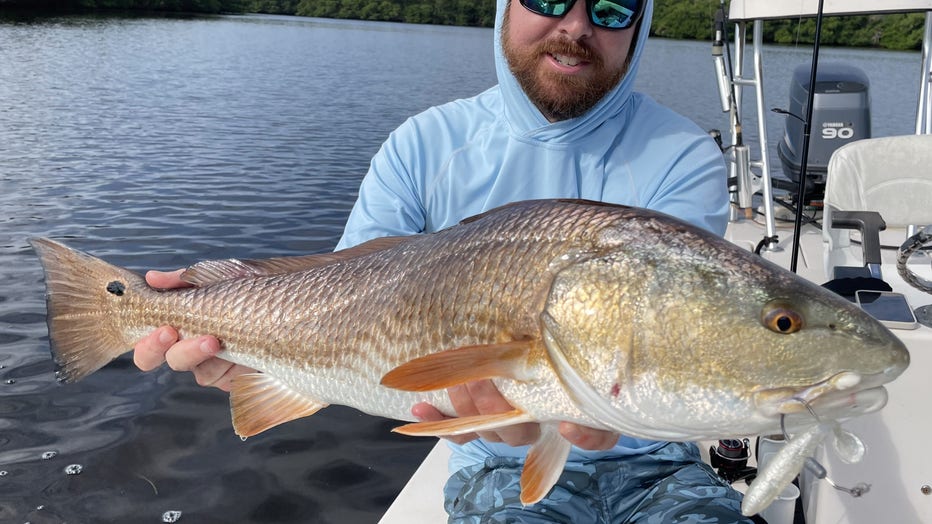
Redfish caught inshore (Credit: Hubbard's Marina)
During the heat of the day, the redfish action has been good around the sandy passes holding to structures. We had several redfish caught around John’s Pass, Blind’s Pass and Clearwater Pass this past week around those deeper sandy areas adjacent to docks, piers, bridges, and jetties. Using live shrimp or the swim baits or soft plastics right on the bottom is the best option for these areas.
Keep in mind, during the dead of night, bridge lights and dock lights will also provide an opportunity to catch some reds, but they will always be at the bottom and look for docks or bridges where water is moving, and bait is present. My favorite dock lights are always near the points of canal entrances adjacent to the passes, choke points or near grass flats where tides are pulling water from the flat to the docks.
Snook action is going well around the area too but it was a little softer compared to the redfish show. We are seeing a majority of the snook be the schoolie-sized, more active juvenile fish during the day on the flats. However, if you can soak out the edges of the flats or the deeper holes around the flats with big cut bait, you can find the big breeder sized fish. Most of the time, the bigger snook are caught at night this time of year around the bridges, big dock structures and deeper areas around the flats at night fall, through the night, or early morning.
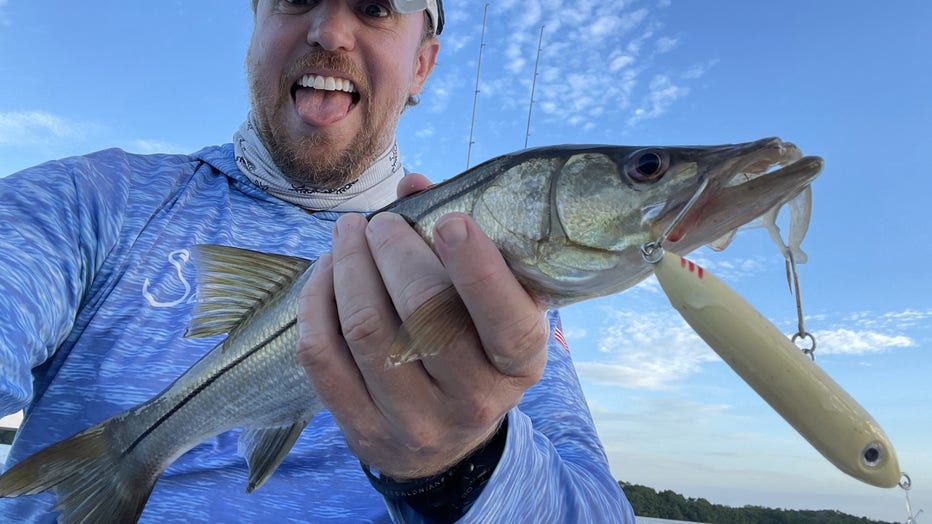
Snook caught inshore (Credit: Hubbard's Marina)
During the heat of the day those big fish, even when located, are often just going to chill and wait for the cooler temperatures to set in before feeding. Fishing the shadow lines of bridges and docks at night is a great way to target the bigger snook. They get extremely opportunistic and leader shy in these warmer waters.
Some hardcore pass fishermen will throw those big flairhawks, bomber lipped plugs, or the bigger swim baits to target the big girls moving through the passes. You may not have the action using these lures compared to a soft plastic or rattletrap but when you get hit your typically seeing bigger fish. smaller 8-12 inch mullet make extreme cut baits or even live baits around the bases of bridges for targeting the bigger snook. However, if you want the most action, using smaller artificial baits or live shrimp and lighter tackle is best.
Trout action is still going steady around the area, but they are still holding to the deeper flats during the day where there’s a bit cooler water. Also, we are seeing them along our beach fishing piers, around local bridges and passes, plus along the beaches too. Look for them in the swash channels of the beaches, hunting soft plastic paddletails, live shrimp or the white bait. Live shrimp is a great second option.
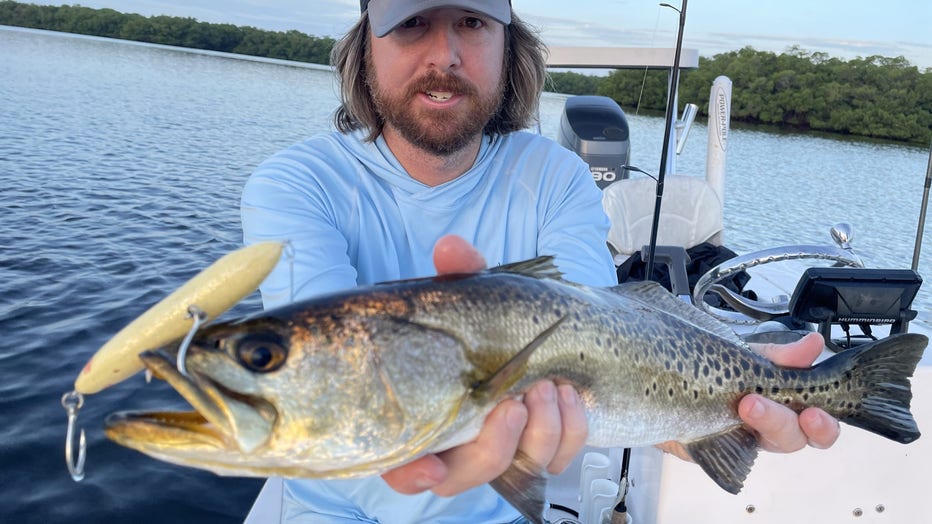
Trout caught inshore (Credit: Hubbard's Marina)
There’s still some snook and redfish cruising the beaches too right now, as well in the swash channels with the trout. Early morning, dusk or through the night continues to be the best time to find more actively feeding fish.
Mangrove snapper action is really going well around the area too and typically around this time of year is our last big chance for targeting the plethora of snapper inshore. Once October rolls in, the cold fronts could eventually get started up. The snapper spread out and the bigger ones will be triggered to move near shore and offshore with the moon phases.
Get them while they are biting well around those structures, rock piles and bridges. A great time to target them is right on the start of the incoming or outgoing tide just as the water starts to move but is still moving slowly.
Sheepshead are around many local structures still and you will often see them or find them intermixed with the snapper around the local bridges, docks, seawalls and even sometimes out on the flats. They will only get more prolific and concentrated as the water cools, but for now, you can still get lucky when targeting mangrove snapper on lighter tackle with smaller hooks and a small chunk of shrimp.
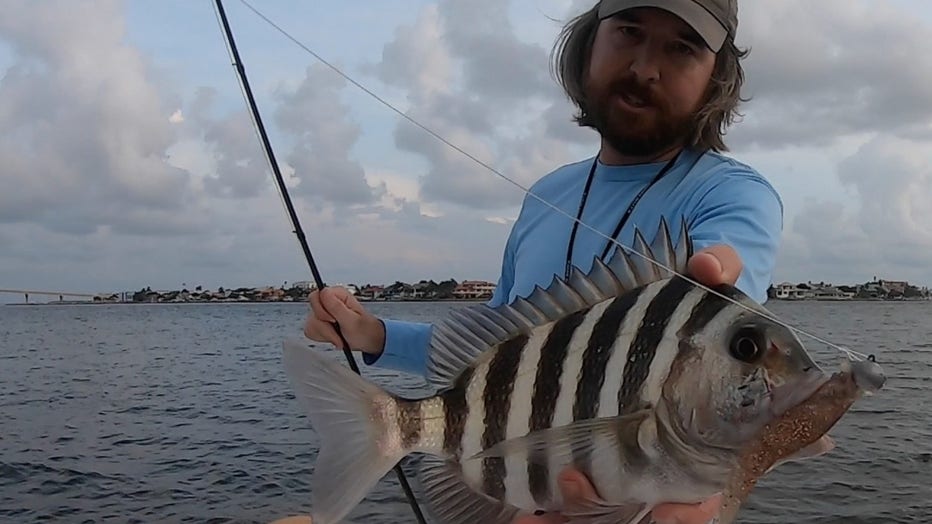
Sheepshead caught inshore (Credit: Hubbard's Marina)
Mackerel are biting well along our coastal fishing piers and bridges of Tampa Bay. We are seeing larger areas of bait schools which are holding typically plenty of mackerel.
Plus, the jack crevalle too are getting more and more prolific in the area as well. If you find the bait being actively fed on when they are up on the surface disrupting the surface of the water and attracting birds to dive on them. It’s always thanks to some hungry predatory fish below and 99% of the time that’s going to be a big school of mackerel or jacks. Fast-moving flashy lures are always best for these hungry and aggressive fish.
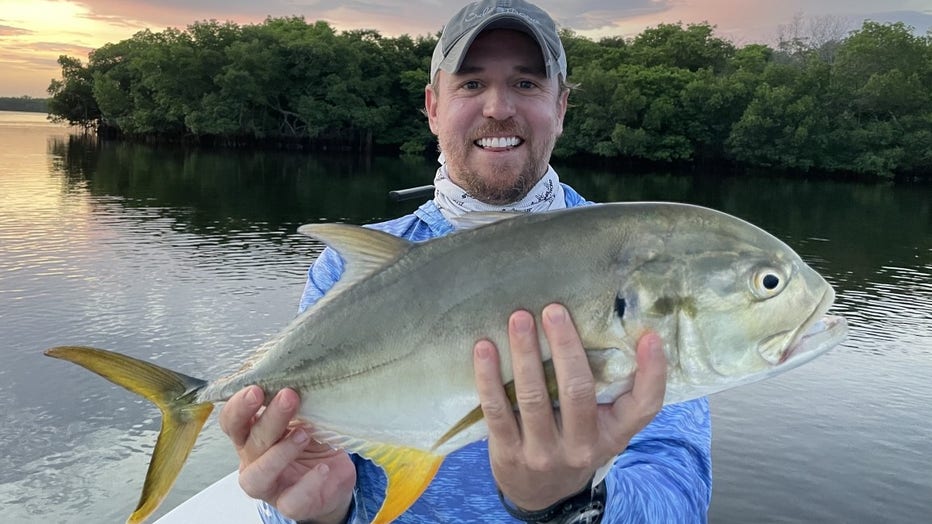
Jack crevalle caught inshore (Credit: Hubbard's Marina)
Pompano action is slow and steady around the beaches, local fishing piers and bridges near the mouth of the passes and the bay. We are starting to see them more frequently but they will pick up as ‘fall’ approaches and that transition between the hot summer time water and cooler ‘wintertime’ water sets in. Look for them in those clearer water areas where water is moving. Live shrimp, pompano jigs or the small soft plastics are great options to target these fish right on the sandy bottom areas.
Triple tail are thick around the beaches and around the bay right now. It’s a great time to hunt the buoys, markers and keep an eye out for floating debris from upper to lower Tampa Bay and along the flats, beaches and even once offshore!
Near shore
We had a killer bite of red grouper early to middle of this past week prior to the little weather disturbance we have had. They were biting extremely well for us right ahead of that low approaching the area.
We are finding them best around the 80-100 foot mark and doing best using larger dead baits. Unfortunately, it seems the red grouper bite is only getting better and better, but we will see an announcement next week that red grouper will be closing for the year due to the "ACL," or "Annual Catch Limit" being met or projected to be met.
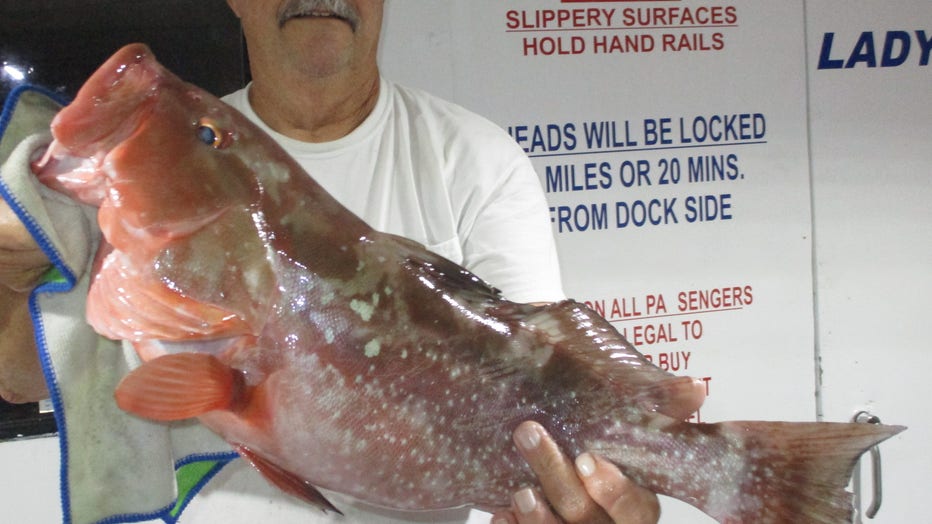
Red grouper (Credit: Hubbard's Marina)
This is frustrating, annoying, and sad but its good news too. Want to know why? Well, that shows the fishery is rebounding and they are recovering, and science supports this idea. We have seen the council’s SSC or Science and Statistical Committee raise the average red grouper size this year with their review of the SEFSC or Southeast Fisheries Science Center’s interim analysis. This means the overall average size of the red grouper caught is getting larger which is a great signal of the stock’s overall health improving.
However, with a larger average size comes the likelihood that the quota will be caught up more quickly. Plus, coupling that change with the fact we are really catching them well, and it adds up to a very strong likelihood of a closure. I figured this would happen and my thoughts were confirmed at the last Gulf Council meeting when they reviewed reef fish landings and even stated there’s likely a red grouper ACL closure coming.
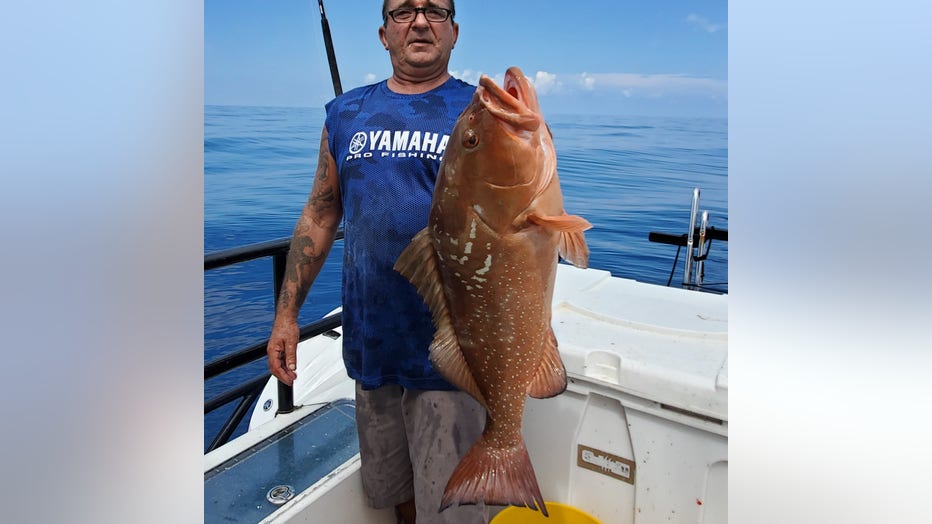
Red grouper (Credit: Hubbard's Marina)
I had hoped it would come later in the year, but we will likely see it follow shortly after their announcement coming next week. The other positive news is that the council currently has two framework actions in the mix right now that will help improve the recreational quota and catch level for the entire fishery.
These changes will hopefully be in effect prior to end of summer or fall next year which should and likely will allow us to get nearly a full 12-month season back in 2022. It’s been very frustrating this year, but again, it’s good news the fishery is rebounding and us giving them a break for a few months at the end of this year should help even more with the red grouper really making a strong bounce back.
We are also seeing a lot of lane snapper near shore right now on the cut threadfin, small squid chunks and live shrimp. Plus, the mangroves are nearly almost as present near shore. They’re just a bit trickier to get eating like the lane snapper. We are extremely excited to see what these guys will do as that water temperature starts to dip a bit. A lot of times, they get feistier and more prolific.
Hogfish action is present, but not going super well. However, the hogfish bite is just around the corner from really turning up to a great option near shore.
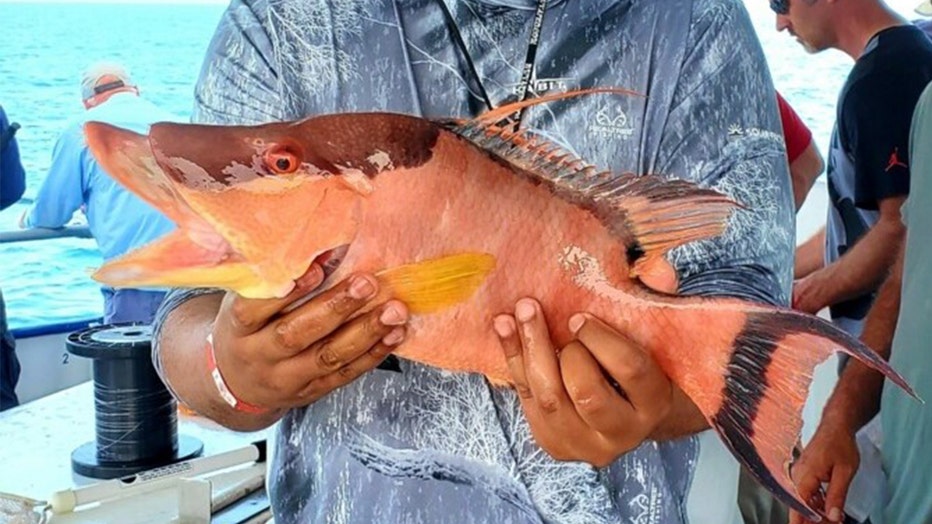
(Capt. Dylan Hubbard)
Mackerel are more prolific near shore right now and we’re just a few weeks away from the kingfish making an appearance near shore. Likely, this upcoming full moon on the 21st of September, people will start to see a few schoolie-sized kings near shore and along the beaches, but they should be in full swing by early to mid-October if weather patterns hold to the norms.
My only concern is the red tide along the coastline. If that stays there, we could see the kingfish skip the near shore waters and stay deeper kind of like we witnessed this past spring.
Offshore
Amberjack fishing has gotten tough on us recently but we’re still plugging away at hunting them here and there. I thought this year we would see a very slow August, but I was proved wrong. Through most of August into September, we had a really decent amberjack action on our long-range trips.
However, the last few 39-hour trips saw a severe change in that pattern and we are still struggling to find big concentrations of these fish while bouncing around offshore on the Flying HUB 2 private fishing charters and the 12-hour extreme. Hopefully, we are going to see another push of these fish prior to the end of October when their season will close again until May of next year.
Red grouper action is going well out deep right now too and it’s a great time to get them while you can prior to that potentially looming closure. We are seeing them well around that 120-160 foot area but the deeper you go the bigger they get.
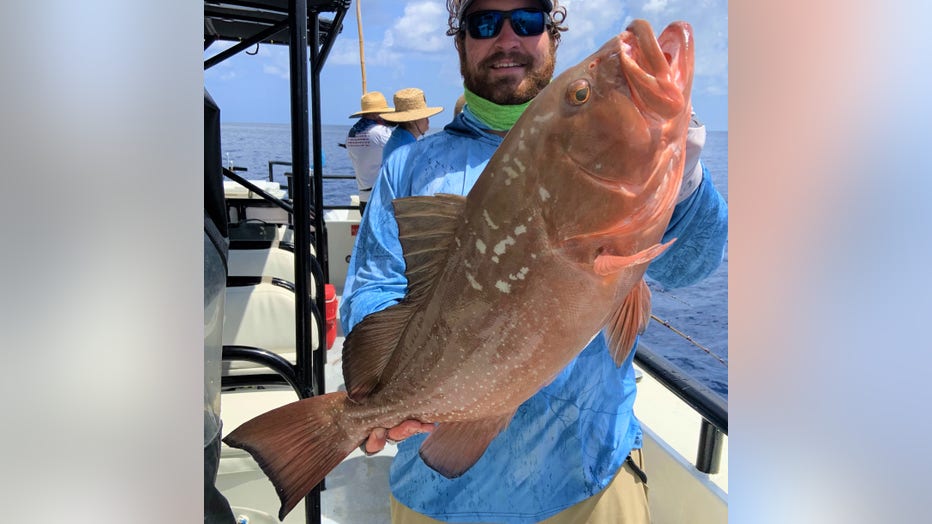
Red grouper (Credit: Hubbard's Marina)
Still, there’s plenty of smaller undersized fish mixed in with them and it’s super important to make sure you have a good de-hooker and barotrauma mitigation device ready. Some prefer the descending devices, some prefer venting tools, but either way you just must have one or the other ready to rock and roll when fishing offshore and even in the deeper near shore waters when the water is this hot.
Mangrove snapper have been super cooperative and very large overall when fishing out there around 120-160 feet of water hunting those red grouper, gag grouper and scamp.
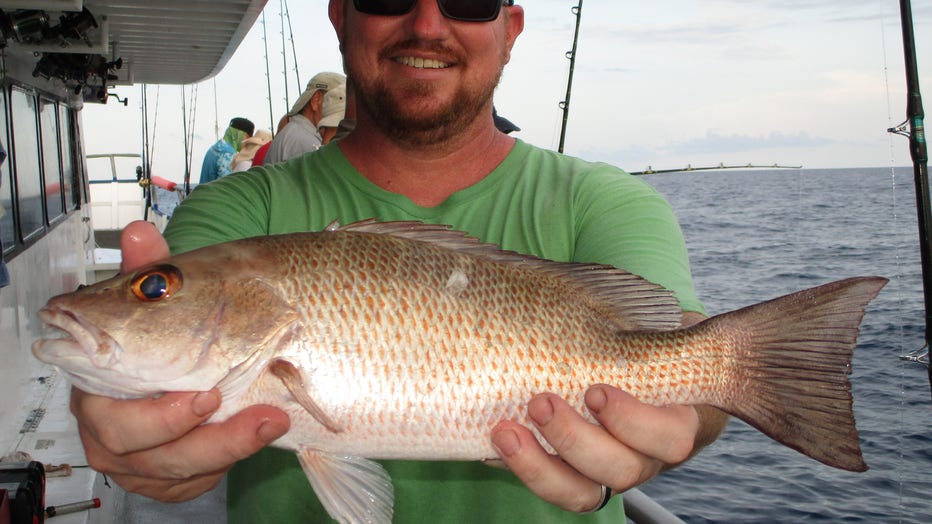
Mangrove snapper (Credit: Hubbard's Marina)
Using the tried and true double snell rig with the typical Carolina rig set up is the primary method for the mangrove snapper with around 40-50lb test leader and around 5-6ot hooks and a cut chunk of threadfin.
We are seeing a good number of yellowtail snapper around still as well. Plus, the vermillion, porgies, and lane snapper mixed in with the mangroves offshore too so plenty of action while targeting your mangroves, gags, scamp, and red grouper.
Once red grouper closes, we will really hunt the scamp, gags, mangroves, yellowtail and other heads and tails. Plus, were going to see the tuna and kingfish pick up as October rolls in plus the chance for big wahoo is still around too!
DON’T BE A FOOL, bring a venting tool & Descending device
Keep in mind the importance of dead discards and discard mortality when engaged in near shore or offshore fishing. How many do you know right now that are all for catching and releasing snook, redfish, and trout but will be the first in line to kill a mangrove snapper, gag grouper, or red snapper? But the attitude completely changes when discussing these offshore species?
Plus, the same person inshore that will hold their breath and wet their hands before handling a breeder snook will go offshore and then cull through 20 red snapper before keeping their two red snapper they deem large enough to fill their two-fish bag limits. Meanwhile, the other 18 they released will often end up suffering fatal damage if not properly descended or vented?
Please help us to spread the word on the importance of descending or venting your released fish. Descending devices are most easy to use and quick to pick up on their use. They are most effective for most anglers.
However, an expert and precise angler with proper training and tons of experience can use a venting tool properly with similar outcomes. A venting tool requires you to pierce the fish while most descending devices are much less invasive. While using a venting tool, it is imperative you pierce them in the exact right spot, and you do not go but a quarter-inch or less in the fish. Most venting tools require you to ‘choke up’ on the tool to prevent over-penetration into major organs.
When fishing deep water, especially in the hot summer months, please make sure to treat all fish intended to be released like that breeder snook inshore and minimize the time it takes you to get him from the bottom to the boat using heavier proper tackle, not an ultra-light spinning reel.
Then once onboard, minimize the time out of the water. Then use a proper de-hooking tool and then, for the love of God, use a descending device or venting tool PROPERLY to ensure that fish has a chance to live another day.
Three things will help ensure the survivability of those fish released offshore:
- Making sure they are brought up quickly and do not expend all their energy in the fight.
- Make sure they are unhooked smoothly, easily, and as quickly as possible.
- Finally, make sure they spend the least amount of time at the surface at negative pressures where barotrauma exponentially increases its effect with each passing second.
Also, keep in mind when the water is warm, there is less dissolved oxygen content and the chances of barotrauma increase even more while its effects can be even more deadly.
LINK: Here’s all the information and more on barotrauma and how to mitigate that fatal damage to your future offshore catch
**Note: I recommend the Salt Strong articles at the bottom of the page under ‘webpages.’ I helped them develop those personally.
STATE SURVEY to improve recreational data and access
It is imperative that you have your Gulf Reef Fish survey endorsement on your fishing license.
You should get one if you are a private recreational angler or diver fishing from a private boat anywhere in Florida who intends to harvest, attempt to harvest or possess one or more of the following reef fish species: mutton snapper, yellowtail snapper, hogfish, red snapper, vermilion snapper, gag grouper, red grouper, black grouper, greater amberjack, lesser amberjack, banded rudderfish, almaco jack, gray triggerfish, Gag grouper, Red grouper, Scamp grouper, Mangrove snapper, Lane snapper, Kingfish, Tuna, or Mahi mahi.
Here is all the information and more on that program and how you can sign up.
TERMS OF REFERENCE:
INSHORE – from the back bays out to the bridges and including right on the beaches
NEAR SHORE – From the beaches out to 20 miles, or up to 100ft of water
OFFSHORE – from 20 miles or 100ft and beyond
For more fishing reports, photos, videos and more check out Hubbard’s Marina on Facebook, Instagram, YouTube, or Snapchat. Just simply search "HubbardsMarina" and do not forget our family motto, "If you’re too busy to go fishing, you’re just too busy!

